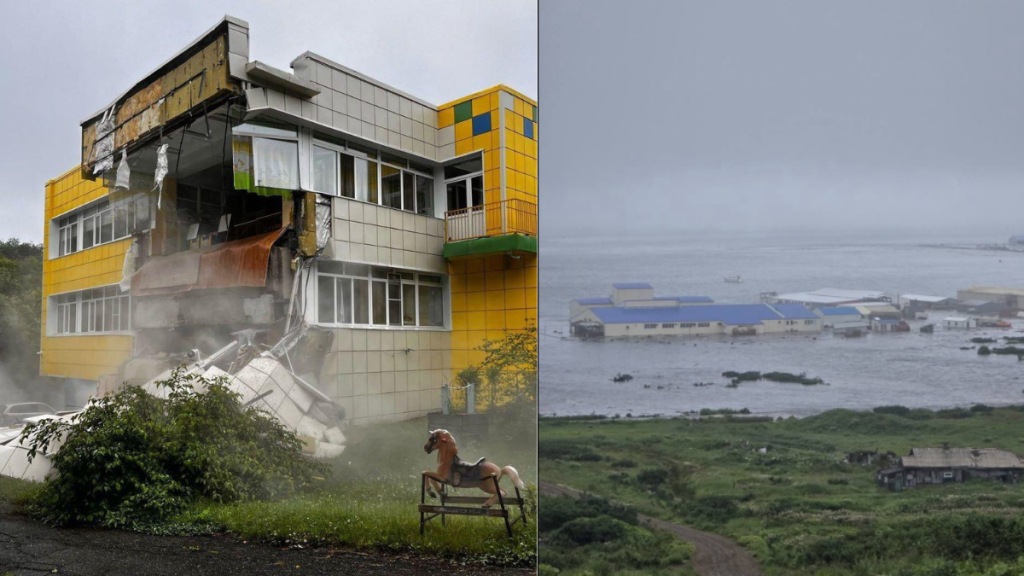An 8.7-magnitude earthquake off Russia’s Kamchatka Peninsula has triggered a chain of tsunami panic across the Pacific, with countries from Japan to Hawaii bracing for impact. The resulting waves have displaced thousands, left travellers stranded at airports, shut down beaches, and caused infrastructure damage. As aftershocks continue and warnings remain in place, much of the region remains on high alert. Here’s an update, as per media reports, on the damage reported so far, and what nations across the Pacific can still expect in the coming hours.
Russia bears the brunt
The epicentre, southeast of Petropavlovsk-Kamchatsky, delivered 3–4 metre high tsunami waves to various regions of Russia’s Far East, such as Severo-Kurilsk in the Kuril Islands. Coastal villages were fully evacuated, buildings were damaged, and a state of emergency was declared. In Petropavlovsk-Kamchatsky, buildings shook, ceilings cracked, and power and mobile communications went down. A kindergarten and a section of an airport terminal were among the buildings affected, with a few minor injuries reported.
Local officials are still on red alert as aftershocks with magnitudes as high as 6.9 continue to shake the area. Authorities cautioned that access to the coastal areas would continue to be off-limits due to concerns over additional seismic tremors and secondary waves.
Japan evacuates close to one million
Japan’s northern coast was hit by up to 1.3 metres of tsunami waves at Kuji Port, with smaller tsunamis closer to Tokyo. The Japan Meteorological Agency (JMA) warned of tsunamis along the majority of the eastern coast from Hokkaido to Okinawa, leading to evacuation advisories for more than 900,000 people in 133 municipalities.
Transportation was widely disrupted, ferry operations were suspended, flights were diverted, and parts of railway operations were stopped. Employees at the Fukushima Daiichi nuclear facility were relocated to higher ground as a precaution. No significant damage or injury has been reported as of now, and nuclear plants are secure.
Hawaii and the US West Coast prepare for more impact
Sirens blared throughout Hawaii as tsunamis as high as 4 feet (1.2 metres) hit shores within proximity of Haleiwa. Officials called for evacuations in low-lying terrain and told residents and visitors to stay off all beaches and coastal facilities until further notice. Governor Josh Green said National Guard resources, such as helicopters and high-water rescue trucks, stood ready in the event of emergencies.
Along the US West Coast, advisories for tsunamis are in effect from California to Alaska. Up to 1 metre of wave surges are anticipated. Emergency authorities in Oregon and Washington issued warnings of hazardous currents and possible waterfront damage. Small waves have already reached Alaska’s Aleutian Islands, albeit without significant destruction.
Pacific and Latin American countries on alert
Nations in Oceania, such as New Zealand, Samoa, and the Solomon Islands, put out warnings of “unusual and strong currents” and coastal surge. Governments asked people to evacuate beaches, ports, river mouths, and marinas. Waves are forecast along the entire Pacific coast of New Zealand.
Across the Pacific, Latin nations like Chile, Peru, Ecuador, and Mexico are preparing for waves measuring 1–3 metres. Coastal communities have been evacuated, beaches shut down, and sea activity halted. In Mexico, the navy issued progressively more urgent warnings along its Pacific coast, with the first waves due to reach Ensenada early on Wednesday morning.
Asia-Pacific, China is also in wait
Southeast Asian countries such as Indonesia and the Philippines warned of 1-metre high waves. The Philippines implemented beach closures on its east coast, and authorities warned that even small waves could pose dangers because of powerful currents. China, Taiwan, and eastern Australia also issued public notices advising people to stay away from coastlines.
Aftershocks, prolonged risk expected
Governments around the Pacific are calling for sustained caution. Seismologists say tsunami events may develop over hours, sometimes more than one day, with wave heights that are difficult to predict. Some officials noted that the following waves might be higher than the leading surges.
Though there has been no reported mass casualty as of this writing, the overall effect is extensive: mass evacuations across many areas, damage to Russian infrastructure, transport networks interrupted in Japan, closures of harbours in several countries, and emergency readiness on an unparalleled regional scale.

